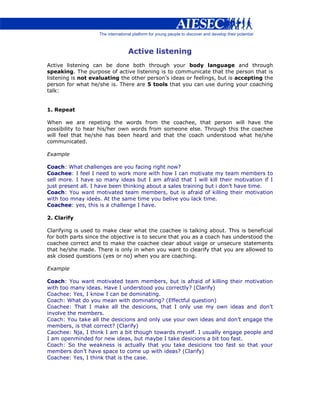
Active listening skill
- 1. Active listening Active listening can be done both through your body language and through speaking. The purpose of active listening is to communicate that the person that is listening is not evaluating the other person’s ideas or feelings, but is accepting the person for what he/she is. There are 5 tools that you can use during your coaching talk: 1. Repeat When we are repeting the words from the coachee, that person will have the possibility to hear his/her own words from someone else. Through this the coachee will feel that he/she has been heard and that the coach understood what he/she communicated. Example Coach: What challenges are you facing right now? Coachee: I feel I need to work more with how I can motivate my team members to sell more. I have so many ideas but I am afraid that I will kill their motivation if I just present all. I have been thinking about a sales training but i don’t have time. Coach: You want motivated team members, but is afraid of killing their motivation with too mnay ideés. At the same time you belive you lack time. Coachee: yes, this is a challenge I have. 2. Clarify Clarifying is used to make clear what the coachee is talking about. This is beneficial for both parts since the objective is to secure that you as a coach has understood the coachee correct and to make the coachee clear about vaige or unsecure statements that he/she made. There is only in when you want to clearify that you are allowed to ask closed questions (yes or no) when you are coaching. Example Coach: You want motivated team members, but is afraid of killing their motivation with too many ideas. Have I understood you correctly? (Clarify) Coachee: Yes, I know I can be dominating. Coach: What do you mean with dominating? (Effectful question) Coachee: That I make all the desicions, that I only use my own ideas and don’t involve the members. Coach: You take all the desicions and only use your own ideas and don’t engage the members, is that correct? (Clarify) Caochee: Nja, I think I am a bit though towards myself. I usually engage people and I am openminded for new ideas, but maybe I take desicions a bit too fast. Coach: So the weakness is actually that you take desicions too fast so that your members don’t have space to come up with ideas? (Clarify) Coachee: Yes, I think that is the case.
- 2. 3. Solve knits The tool means that you should listen for “knits”, put words for them and then solve them. “Knits” are statements that the coachee has decided to view as equal to eachother. Example: “If I say what I mean, no one will like me”. Here the coachee has pointed out that expressing opinions is the same as dissatisfaction. If this happens you should put words on what you are noticing, for example “What you are saying gives me a sign that you think that expressing opinions is the same as dissatisfaction, is this correct?” After this you should ask for other consequences that the statement could give. 4. Interrupt To interrupt is viewed as a bad habit in many cultures. One way of showing interest is to let the person finish what he/she says at the same time we are nodding our head. But coaching is not a normal coversation since each coaching talk is starting with an agenda. If the coachee is stepping outside this agenda, you as a coach is allowed to interrupt and bring him/her back to the topic. If you want to be polite you can explain for the person what you are doing “I am interrupting you now. What was it that you actually wanted to tell me?” 5. Concluding In a coaching meeting you are striving to reach certain conclusions for example: biggest challenge, first action, deadline etc. To be able to get there you need to use the tool that is called concluding. Questions you can ask to reach conclusions are: - What is the essence in your challenge? - What was your most important learning? - What is the conclusion of your story? - Where do you want to come with this? This will help the coachee to get to his/her point faster and by doing that get more time for reflection. You can also make conclusion for the coachee. For example: - The essence in the challenge seems to be...
